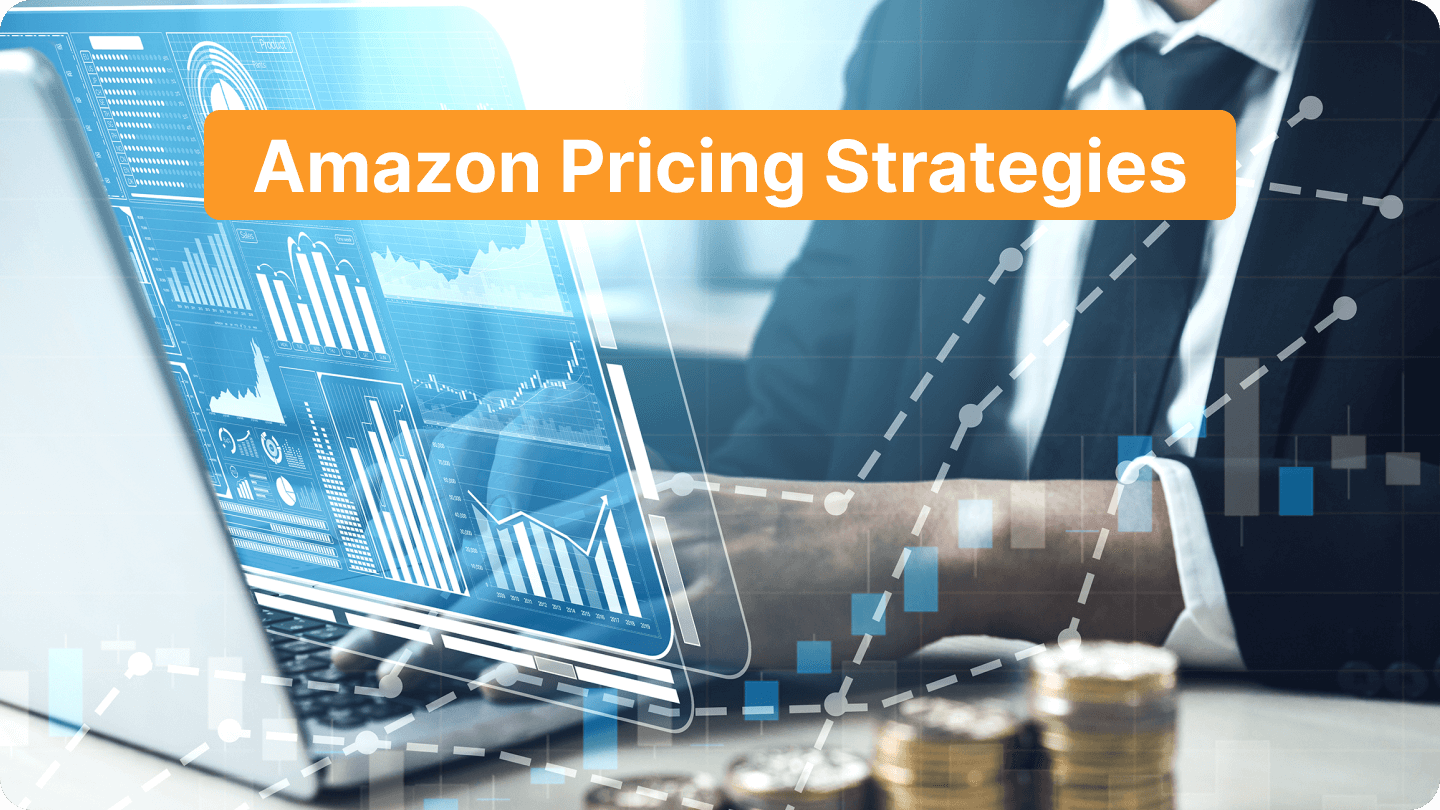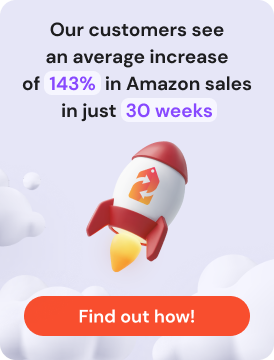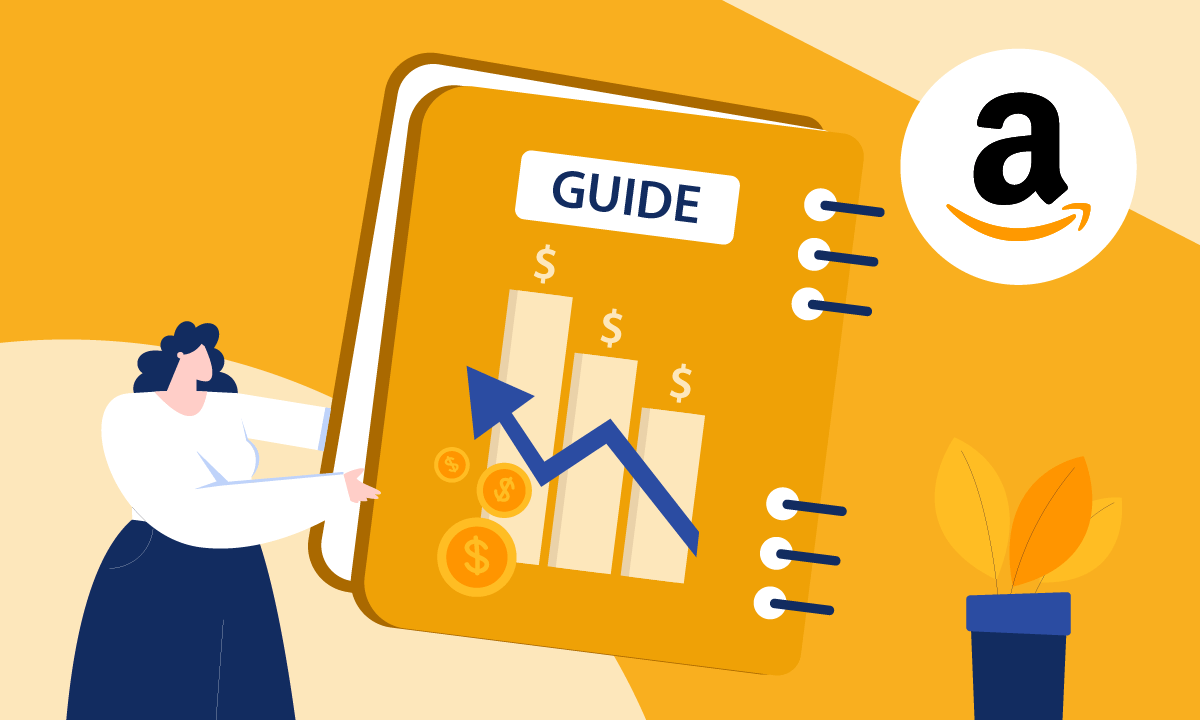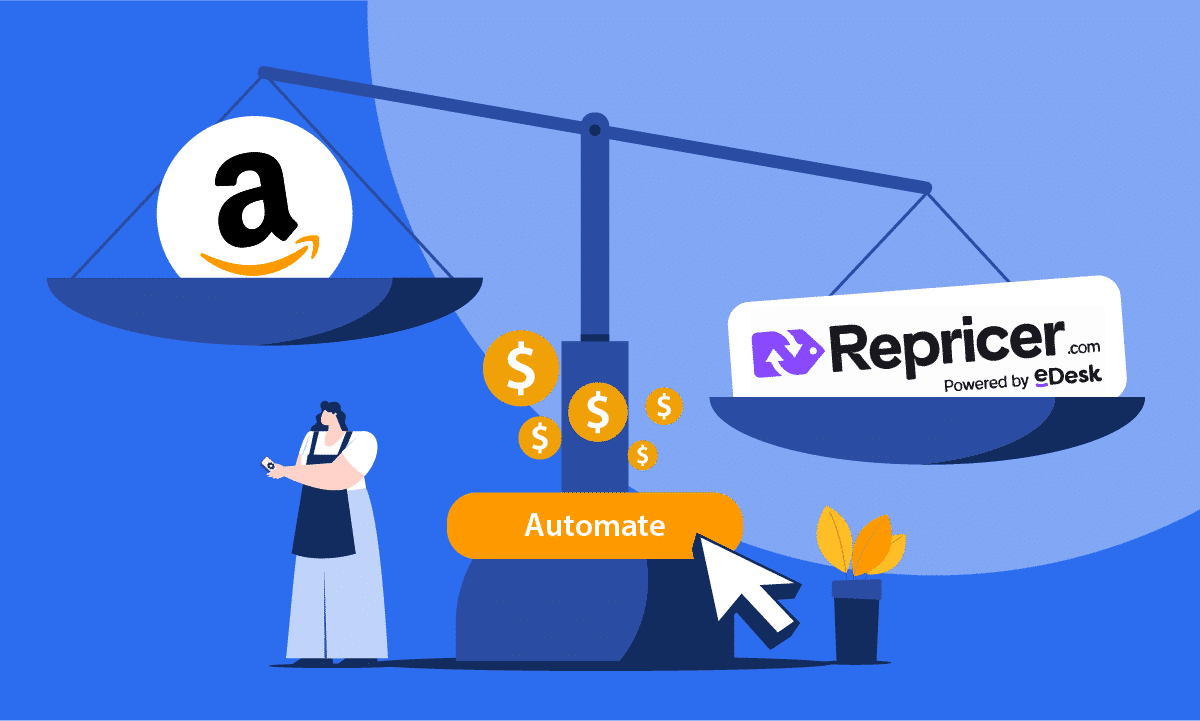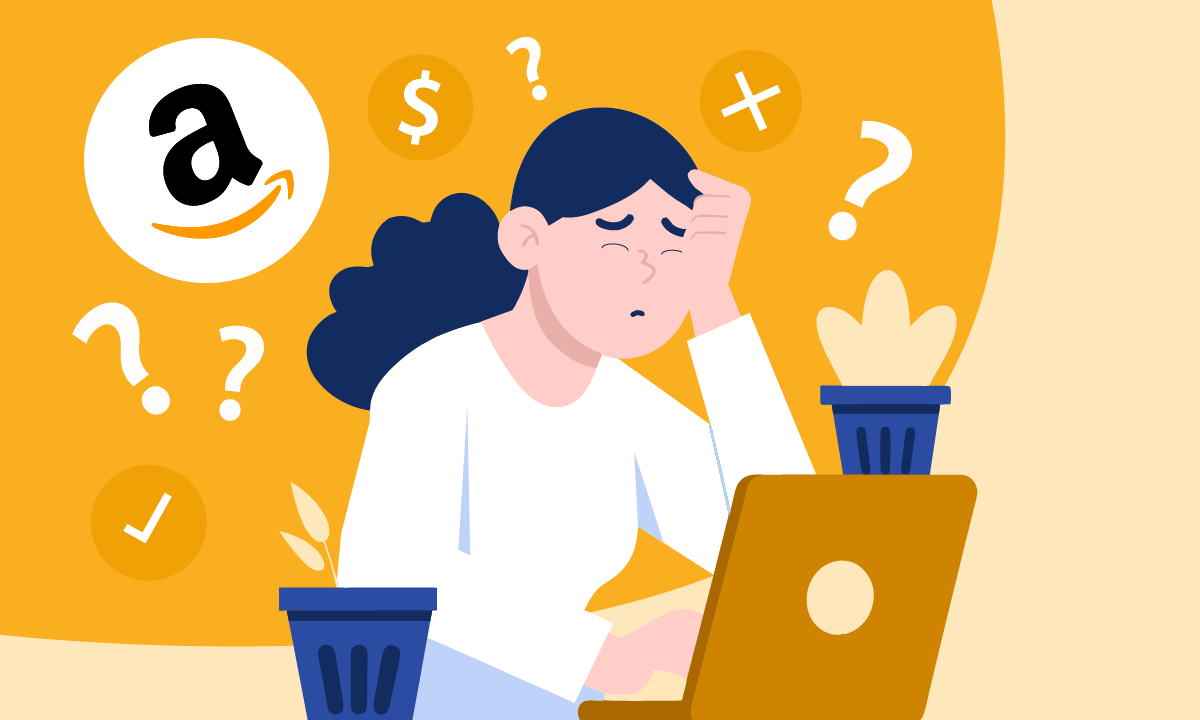Whether you’re new or more seasoned in selling on Amazon, there are many things to consider in running and growing your business for profitability. The obvious things that come to mind include setting up your store, building out adequate inventory, using high-quality images and optimising your product descriptions for SEO.
But one element of running a successful Amazon store that isn’t as obvious – but crucial – is pricing!
Pricing is an often overlooked element of becoming a successful Amazon seller. It’s something everyone wanting to grow their business should be aware of and how it influences Amazon’s algorithm, which ultimately determines how visible your products are and how you stack up against your competitors.
So let’s take a dive into pricing on Amazon, how Amazon’s algorithm works regarding pricing, and what you can do to optimise your pricing strategy as a seller to help your business perform optimally on Amazon.
How does pricing on Amazon work?
How a seller prices their products on Amazon is competitive. You always want to be at (or ideally slightly lower) price points than your direct competition so that shoppers choose your product over a similar one.
It’s not just about undercutting the competition though! While sellers always want to have the most competitively priced items (because those are the items that will sway customers to make a purchase) well-priced items are also more likely to win the highly coveted Amazon Buy Box.
That said, pricing on Amazon is a little different than in a traditional brick and mortar shop since Amazon uses an algorithm to prioritise which sellers’ products get seen and promoted on the platform. So simply reducing your prices doesn’t mean you’ll come out ahead of competitors!
You should also be aware that pricing on Amazon doesn’t just include the pricing of each product sold. There’s also the shipping cost, discounts or coupons/vouchers and any low-price guarantees.
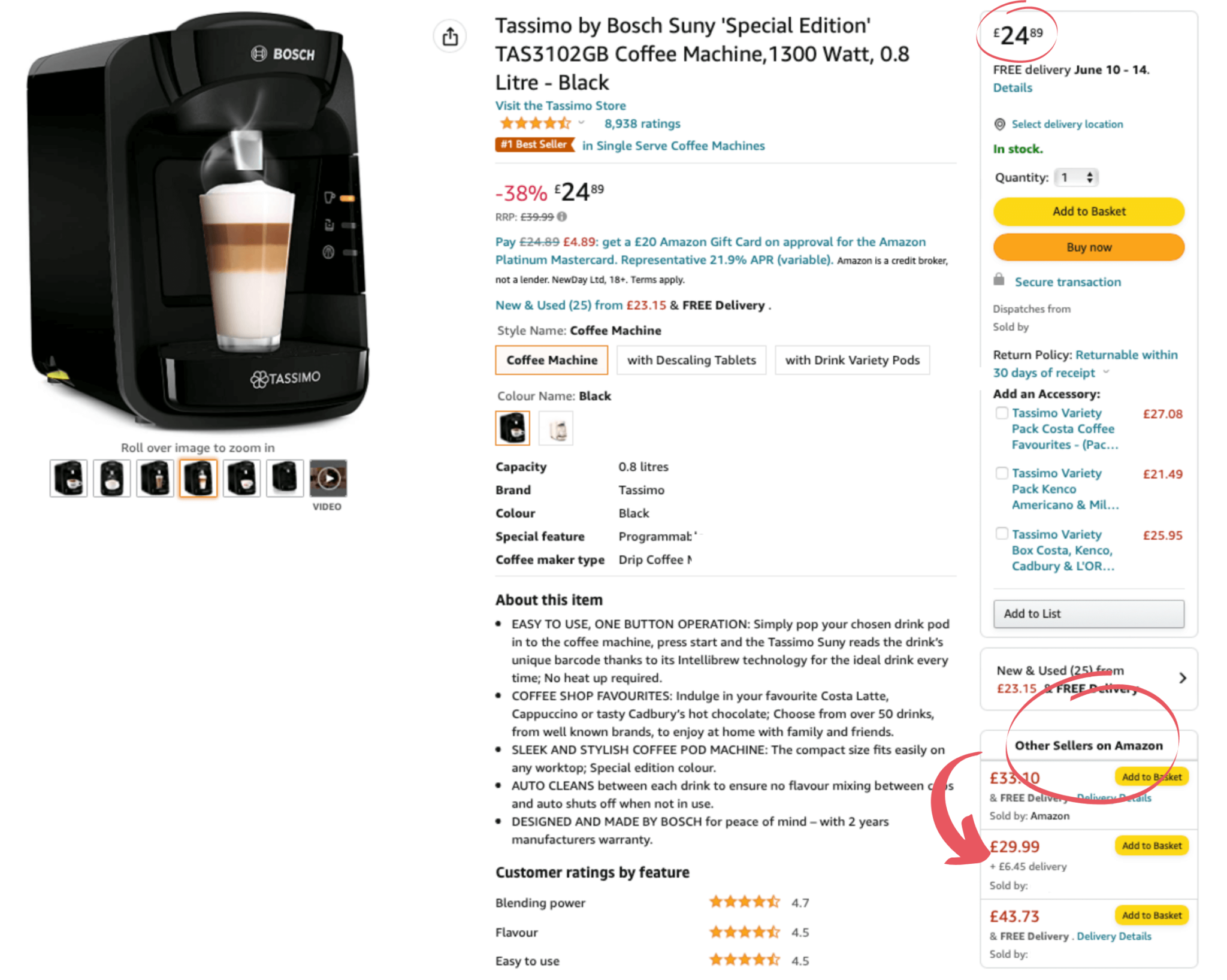
These items figure into what’s known as the ‘total price’ on Amazon. And that’s what informs the algorithm and can affect your position regarding the Buy Box or the ‘Other Sellers on Amazon’ section. As you can see, there are multiple factors involved in pricing products on Amazon.
Competitive pricing wins on Amazon
There are several factors involved in winning the Buy Box. Amazon won’t simply give the Buy Box to a seller with the lowest prices. Although there is some priority given to sellers who keep their prices low for buyers, there are a number of other factors at play.
These other factors include rewarding sellers who offer the best service and maintain a good reputation. The objective on the Amazon platform is to combine reputation (in the form of favourable customer reviews) with a competitive price (which includes not just the item price but also shipping) to win the Buy Box.
There are several main strategies for pricing on Amazon:
- Economy: This strategy is achieved through the use of small profit margins, meaning your product is open to a large market. Typically, products sold under this strategy are non-brand-name products, such as everyday items, offered at low prices with no shipping costs. Economy products don’t tend to ever go on sale because they don’t need to; their purpose is to be accessible, cheap and useful.
- Premium: This strategy is the inverse of the Economy strategy. It leverages brand name products to reach shoppers, and since brand name products are typically higher priced, the Premium strategy uses discounts or special offers to generate consumer interest.
- Skimming: This strategy is a bit of a market-tester. It typically starts at a higher price and then lowers that price using sales when competitors begin to offer similar products at lower price points. Electronics brands often rely on this strategy.
- Penetration: This strategy captures a large swathe of the market by launching new products at lower price points than competitors. This is done through innovative marketing techniques that offer special, limited-time sale prices on items. Prices will then go up after initial sales goals are met since pricing lower is unsustainable in the long term.
There are many ways to price products, and all of these strategies will influence the Amazon algorithm and how your products appear. Ultimately, none of these strategies is static, and as a seller, you’ll always need to be reviewing your pricing strategies and adjusting, especially as market prices in general don’t stay the same.
Given market fluctuations and changes in prices in any given week, this means that prices can change continuously. And that is where repricing comes into play. Amazon sellers need to be repricing their items all the time to stay competitive, stay ahead of the market and ensure that others don’t outperform them.
Price drops on Amazon
It’s important to note that Amazon’s algorithm recognises changes in pricing, both in regards to item price and shipping price. If a seller changes the price of their product or changes the amount they charge for shipping, this will be picked up by Amazon and incorporated automatically into product rankings on the platform.
This is why it’s essential to stay on top of competitors’ pricing. Pricing is dynamic and influences the algorithm dynamically too, so you always want to be aware of what’s happening with competitors’ price drops and how this might affect your ranking.
What is repricing?

Repricing is a strategy wherein you ensure that your prices are competitive with other sellers without undercutting your profit margins.
When you’re selling on Amazon, keeping your pricing competitive will help you gain a better position in the market and work towards winning the coveted Buy Box. This can mean lowering your price by as little as £0.01 from your competition.
This is also why repricing is so crucial. Prices are constantly in flux, so sellers have to stay on top of changes in the market and respond accordingly, which means repricing products regularly.
Sellers can reprice manually, going in and altering their item prices one by one through Amazon Seller Central. But this can be time consuming and burdensome, even though it does give you an understanding of the market and competitors’ prices.
Still, manual repricing is not a long-term solution, especially if you want to grow your store. That’s where Amazon repricing software comes in. Repricing software such as Repricer will automatically update your product catalogue with the most competitive prices.
Repricing software is fantastic because it updates prices dynamically depending on what’s happening in the market. So it takes the guesswork out of constantly monitoring and updating your products one by one.
Using repricing software, Sellers can set rules to not go beyond a specific floor or set other parameters, like minimum pricing, to ensure margins are never lost.
How repricing software works in practice
Here is an outline of how repricing software works in a nutshell:
A competitor changes their pricing on Amazon. This change is flagged by the repricing software, which then calculates a new price and updates it on Amazon.
As you can see, the process is dynamic, occurs in real-time and makes it easy for sellers to continuously ensure that their prices remain competitive.
There are two types of repricing: rule-based repricing and algorithmic repricing.
Here is how they differ:
Rule-Based Repricing
This is where the seller sets the parameters for repricing. For example, you could set a rule to automatically reprice a specific competitor by £0.01 per product.
With rule-based repricing, it’s still driven by the software, but there are many rules you can manually set to optimise how the software works, which gives you control over how you run your repricing.
Rule-based repricing could be the ideal solution for those who like to do things manually and follow market movements closely. At Repricer, we’ve put together some flexible rules you can follow to make manual repricing simpler, with lots of useful options geared towards increasing your sales.
Algorithmic Repricing
This method is more advanced, as it uses an algorithm-based tool that takes into account numerous metrics to work out what is the best price for your product and that will deliver the best ROI for your business.
This is the more sophisticated form of repricing, and it’s what professional sellers with an extensive catalogue of items use. If you have a lot of items that move fast and you’re looking to expand and grow your business even more, algorithmic repricing will be your best option.
It also constantly stays on top of Amazon’s changing algorithm, ‘learning’ its new changes, ensuring that your repricing strategy is always aligned with the latest in Amazon’s algorithm.
Why should I use repricing software?
The short answer is that if you want to be successful selling on Amazon, repricing software is a must. According to one report, Amazon sellers who used a repricer to automate pricing saw an increase of 145% in weekly sales across 30 weeks.
For businesses that want to scale, it’s not practical (or really even possible) to manage repricing manually in the long run. While manual repricing can be insightful when used by smaller businesses to understand pricing trends, once businesses grow and their product catalogue increases, it’s unsustainable to continue to reprice manually.
Repricing software is an excellent tool to uplevel your Amazon store, stay competitive, and win the Buy Box. It will adjust prices automatically, it can handle large product catalogues, and it can maximise your ROI.
While it does come with a price tag, it’s worthwhile when you balance the cost of repricing software against the increased profit you’ll see by having more competitive prices and potentially winning the Amazon Buy Box.
More on the Amazon Buy Box
We mention the Amazon Buy Box a lot since it is, in a way, the holy grail of Amazon sellers. But what is it exactly? Well, it’s the box that appears on an individual product page when a shopper searches for an item.
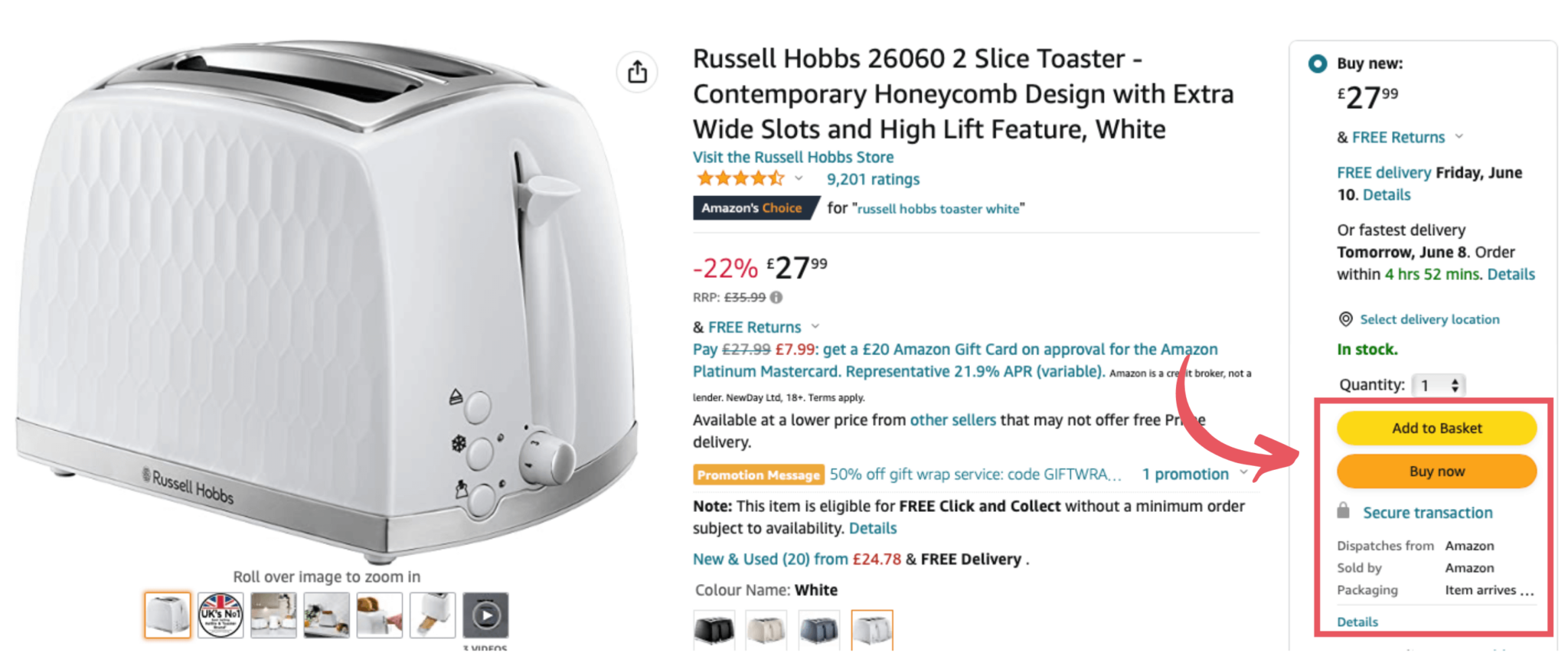
The Buy Box appears on the product detail page, which leads the shopper to buy the product. It’s the quickest and easiest way for a shopper to buy on Amazon.
That’s why winning the Buy Box is so important: it increases your product’s visibility and makes it more likely that you’ll get a greater number of sales. In fact, 82% of Amazon product searches that become sales are achieved through the Buy Box. That’s quite significant!
As mentioned above, winning the Buy Box means mastering Amazon’s algorithm. The factors that influence whether your product will win the Buy Box include:
- Price: This is where repricing comes in! Amazon’s algorithm considers product and shipping prices when selecting products for the Buy Box.
- Number of positive reviews: The number of positive reviews your Amazon store has reflects how strong a seller you are. Stores with a more significant number of reviews – and the more positive reviews – will be prioritised for the Buy Box.
- Shipping time: If a seller uses Fulfilment by Amazon (FBA), they are more likely to score better regarding shipping since items to be shipped will originate from a fulfilment centre.
Many factors are within your control when it comes to optimising your store and succeeding as an Amazon seller. Pricing is one of these and is a critical element in the Amazon recipe for success, so it’s sensible to use repricing software.
The art of pricing on Amazon
Pricing your products on Amazon is a delicate balance of multiple factors influencing how your products appear on the marketplace. Taking a considered approach to your pricing strategy will go a long way to ensuring your business’s present and future success.
Staying current with the pricing strategies that Amazon’s algorithm favours can be challenging for even seasoned sellers, but repricing software can help make life easier – and more profitable. That’s why repricing software should be in every seller’s toolkit.
By implementing repricing software, you give your Amazon store the best chance of getting in front of multiple customers and succeeding in the market for the long term.
Why not try out our 14-day free trial and see how Repricer can competitively reprice your products to maximise sales and improve your profits.
